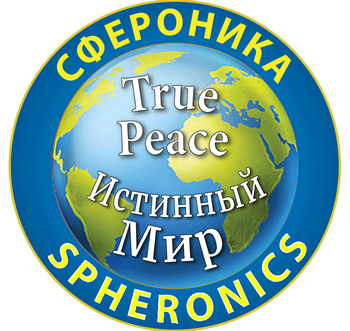
Spheronics: True Peace Megascience
Contents: https://peacefromharmony.org/?cat=en_c&key=1129 7. Digital Technology of Spheral Statistics. Spherons Verification By Leo Semashko, Olga Kashina (+coauthors) Publication: English: https://peacefromharmony.org/?cat=en_c&key=1138 Russian: https://peacefromharmony.org/?cat=ru_c&key=1039 In the previous paragraph, the structural dynamic core as the perpetual motion machine of social production and true peace in their holistic, sociogenetic model-7 was revealed. The approximation to its understanding and mastery humanity began since time immemorial through the understanding and mastery of its separate small empirical parts that continues to this day. This process is endless along with continuous historical updates of all its parts, which are covered by 16 fundamental spheral components of model-7. However, humanity has not yet reached a scientific understanding in the quantitative measurement of this model holistic social dynamics. This is due to the lack of its single, global qualimetric meter and measurement with all the many mathematical attempts to express and approximate it. Their striking examples are the world dynamics mathematical models briefly discussed in the previous paragraph, which, however, are still far from the true and full-fledged social qualimetry. 1. Spheral global statistics: integral societal qualimetry The quantitative measurements of social changes in the society’s dynamics began a very long time ago but took shape as a special tool and cognitive branch only with the advent of statistics, which set the task of digital, quantitative study of qualitative social processes. Officially, the statistics birth is attributed to 1746, although statistical accounting originated much earlier in the ancient states of China, India, Greece, Rome, etc. Napoleon considered statistics as the “budget of things”, economy and two centuries later it became the “budget” of all PIOT resources, all the SIOT spheres, not just the economy, technosphere. In the second half of the 19th century, the scientific discipline of mathematical statistics emerged as a branch of mathematics. Nevertheless, with all the breadth and significance of world state statistics, rooted in all countries, skepticism regarding its scientific validity and reliability, expressed by a well-known catchphrase has not yet been overcome so far. This best statistics imperfection critique is formulated as follows: "There are three kinds of lies: lies, damned lies, and statistics”, the authorship of which remains controversial to this day but the validity of which has not yet been shaken by anyone. The reason for similar skepticism is hidden in the empirical limitations of statistics, its national disunity, in the absence of unified, fundamental classifiers of indices, which so far creates insurmountable obstacles to state manipulation and falsification of statistical data in various institutional interests. However, no matter how imperfect statistics is, it remains the only full qualimetric tool of social cognition, which, like any tool created by human, is open to unlimited development. Similar fundamental stage of its improvement at a higher theoretical level is “spheral global statistics” (GlobStat or GS) based on spheral statistical indices, the development of which began in 1980 at the statistical institute “Lensistemotekhnika” (Semashko. Spheral approach, 1992, pp. 214-243, ets). The model-7 and the basic, generating matrix of spheral indices within its framework were created in it. The traditional statistics limitations are determined by the weakness of its theoretical, macro-sociological basis and simply the absence of a scientific structural model of holistic social production. It is compensated by its structural fundamental model-7, which allows building a fundamentally new, spheral and global statistics as the capital foundation of a holistic, transdisciplinary social qualimetry. It begins with the construction of the basic, generating matrix for the PIOT spheral indices of social production necessary and sufficient resources/products. In the GlobStat the indices basic matrix by dimension of 4x41 includes 16 indices of PIOT resources/products: P1 + P2 + P3 + P4 (= P) I1 + I2 + I3 + I4 (= I) O1 + O2 + O3 + O4 (= O) T1 + T2 + T3 + T4 (= T), where the numbers indicate the PIOT necessary and sufficient resources/products parts at all levels of society from individuals to humanity as a whole (model-3). The designations of their 16 parts obtained from four PIOT make up 16 spheral indices of the spheral statistics basic matrix; the principle of which occurrence determines their generative algorithm: 4x4n. The need for similar generative algorithm of spheral indices is due to the practically infinite dimensionality and an unlimited number of both emerging new historical parts (partons) of spheral components, and the limitedness of their dynamic changes, interconnections and interdependencies. The dimensionality of their qualimetric statistics should not be inferior to them in order to be complete, adequate, without gaps, voids and true, without which it remains open to a variety of statistical manipulations and falsifications. Through the PIOT indices, quantitative changes are expressed not only in these but also in all other spheral components: the PDEC processes, the SIOT spheres and the SIOT spherons on the dynamic model-7. To do this, an arbitrarily large number of the spheral indices matrices for arbitrarily large sets of social objects at different levels of model-3 is generated from the 4x4 base matrix according to the algorithm of 4x4n dimension, where "n" is a series of natural numbers (or other numbers for different calculated tasks of this digital technology). It is understood that the degree of "n" can be limited by any necessary number of sufficient indices to calculate a particular social object or be infinitely large, comparable to the number of elements of neural networks of the brain (~ 100 billion) or trillions of elements of social networks, etc. The basic matrix is built in 4 rows of spheral indices, each of which is divided into four necessary and sufficient parts/indices of the lower level. Each social object of society at any of its levels is associated with one or another part of the spherons does not exist without them as their actors, therefore, they all at any level can be expressed and measured by spherons’ indices, the quantity and quality of their employment. It is measured in certain units: cost, time, energy [11; 12; 13; 14; 15; 16; 17; 18; 31 and others], the consideration of which goes beyond the boundaries of the elementary introduction of our primer. We restrict ourselves here only to natural units of the spherons number. The fundamental attributes of the spheral necessary and sufficient components of social production determine the equally fundamental attributes of the necessary and sufficient spheral GlobStat. Let us list the spheral GlobStat attributes, which traditional statistics lack: 1. Global scale, 2. Fractal nature of statistical matrices, 3. End-to-end nature of spheral indices on all their levels, 4. Recursiveness of the spheral indices generative algorithm, 5. Holism, integrity and transdisciplinarity of statistical matrices [11; 12; 13; 14; 15; 16; 17; 18; 31 and others]. Obviously, other qualities of GlobStat can be revealed. The spheral indices first similar matrix screenshot made at the statistical design institute Lensistemotekhnika, dates back to 1980, a fragment of the upper levels of which is shown in the screenshot here [42]. The GlobStat structure is fourdimensional. It is similar to the dynamic socionome of social production and true peace spheral structure. GlobStat (GS) as a whole consists of four necessary and sufficient parts/segments corresponding to the four SIOT spheres/spherons and their four PIOT products/resources. By spheres they can be called as follows: the sociosphere GS, the infosphere GS, the orgsphere GS and the technosphere/economy GS. By product/resource: the spherons/people GS, the information GS, the organizations GS and the things GS. All together, they constitute a universal and continuous measure of all social processes at all levels from the individual to humanity, necessary and acceptable to all nations and people. The spheral GS is an innovative fundamental qualimetric tool of spheronics, its digital technology of social production and true peace. In spheral statistics, the structurally identical and quantitatively comparable dynamic models of development from each individual to humanity as a whole can be built. Of all the GS segments, the priority is the statistics of spherons, to which the examples below are devoted. There is no need to delve into the theoretical depths of the difference and inseparability of the two logics of thinking of two different but complementary statistics: traditional and spheral statistics, from which the second is built by composing/aggregating the indicators of the first. Traditional statistics are built in logic from parts to the whole, while spheral statistics work in their matrices from the whole to parts, but the resulting calculated indices of which are disaggregated/decomposed into traditional indices of the particular social objects that illustrates their inseparability and mediating complementarity. The deep theoretical characteristics of two fundamental statistics: traditional, empirical and spheral, conceptual, are revealed in detail and illustrated by the examples of many social objects and countries in world statistics by the special book published in four languages, "Gandhica", 2019, (https://peacefromharmony.org/?cat=en_c&key=848). Therefore, their repetition here is unnecessary and inappropriate. Everyone can see them in this source. 2. Transition from traditional to spheral statistics The GS spheral indices general corpus in their categorical predisposition, taking into account dynamic laws, creates the following table (in two parts for compactness) of holistic social production. Empirically, it was presented on model-3, which is the subject of traditional statistics. Now it is generalized by the spheral structure of social production, preparing the subject of the spheral GS based on the normalized composition of the traditional statistics indices into the spheral statistics indices. These tables are used for the second time. The first time they were used to detail and illustrate the model-6 static structure and here they are used in a different function, to illustrate the transition from traditional statistics indices to spheral statistics indices.
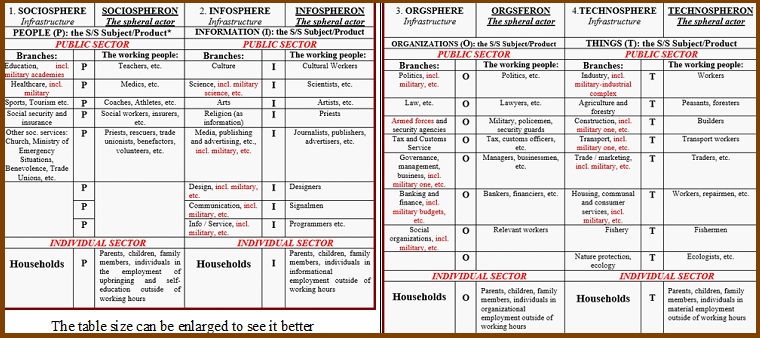
* S/S – sphere/spheron Table 1. Structure of four SPHERES/SPHERONS [32] (Source: https://peacefromharmony.org/?cat=en_c&key=1019) Due to the extreme complexity of this table and the fact that the task of its in-depth analysis is beyond the scope of our primer “necessary and sufficient cognitive minimum” (NSCM), we proceed to illustrate it using a simpler example of one but the key segment of spheral statistics - statistics of spherons/people or the sociosphere. 3. The spherons statistical indices Classifier
A mathematical, quantitative measure of harmony and balance of 16 genetic elements of the socionome on model-7, which ensures social viability at all levels and all social objects, is determined and becomes available for the first time in the spheral GlobStat [5; 12; 34]. Its key part is the statistics of spherons, whose indices are aggregated from the current, traditional statistics for any period/year based on the table/template below. 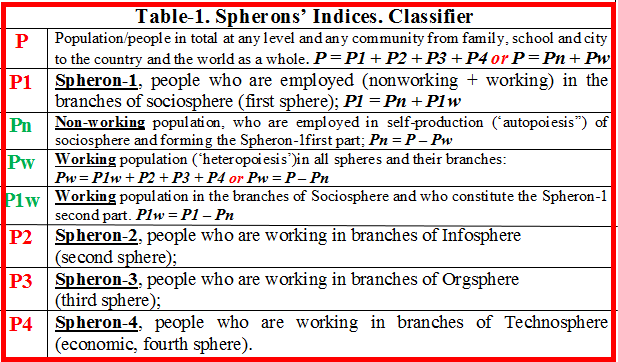
* The spherons main 5 indices are underlined, red, others, 3 are intermediate, green, calculated for the main. Table 2. Classifier of the spherons indices The spherons indices classifier [5, 38-39] is built on the basis and by aggregating the traditional statistics indices presented in their classifier, approved in the statistical documents of the EU and Russia. (Footnote?). Its development in the spherons dynamics of one country is presented below. A unique, unprecedented example of a statistical study of spherons in world statistics belongs to Olga Kashina [33: https://peacefromharmony.org/?cat=ru_c&key=899], the coauthor of our primer, who created statistics on the social structure of Russian spherons in their dynamics over 50 years. It is taking into account the dynamics of both the working population in the spheres public sector and the employed population in their individual sector of households. Based on the spherons' indices classifier, similar statistics can be created for any country, city, corporation and humanity as a whole for any historical period in the presence of initial, traditional statistics. Many similar examples of world statistics of different objects are given in the book "Gandhica" [5].
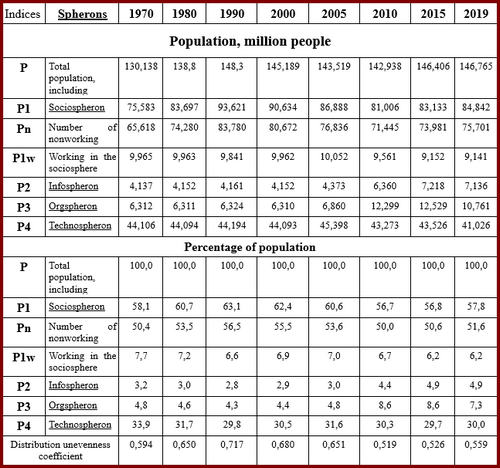
Table-3. Dynamics of the Russia population spherons over 50 years: 1970–2019 [33] 4. Statistical verification of spherons at any social object. Methods. The key importance of the "Spherons Global Peace» (SGP) law for the viability of social nature, humanity makes this natural law the center and system-forming substance of the fundamental Gandhian SM. Therefore, the defining procedure of spheronics, which ensures the inclusion of every literate person in it, is the spherons truth verification at any social object of humanity. It provides a quantum leap in the consciousness of any literate person who has not lost the ability to think independently, from a false to a true level, i.e. from the space of traditionally false consciousness of holistic social phenomena into the space of their true knowledge, thinking and worldview, available for verification. This distinguishes spheronics from all traditional, disparate private humanitarian disciplines and confrontational, false, traditional ideologies of the past and our century (Footnote?). Any presentation of spheronics in any audience for any purpose, especially in scientific research of global peace and in its teaching, should begin since the spherons verification according to the proposed methods. The structural genetic framework of the population spherons at all levels and in all social objects is presented in three visual versions of Table-4 below.
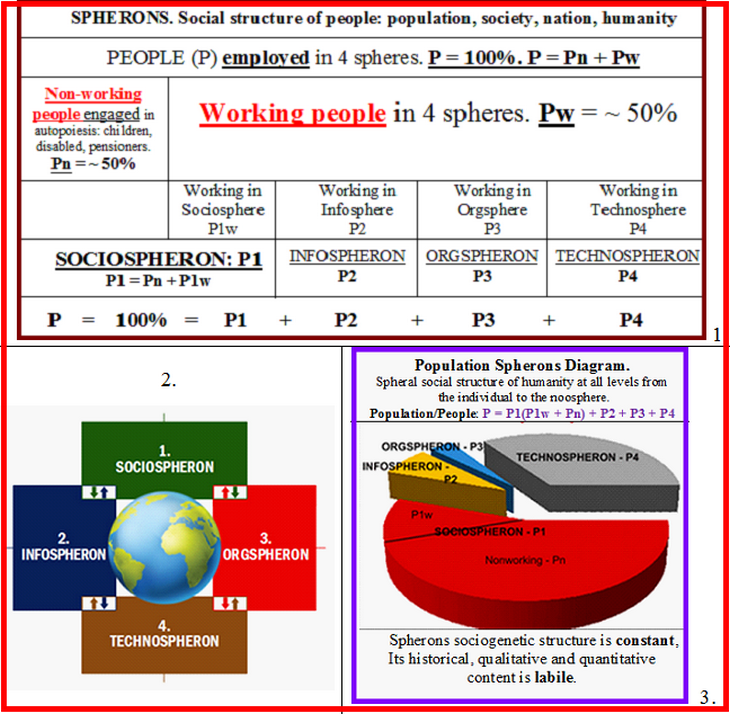
Table-4. Three visual structures of spherons A typical template for statistical verification of spherons at any social object (humanity, population of a continent, region, country, city, enterprise, school, university, etc.) for any given year is represented by Table-5 of spheral indicators below, built on their classifier. The numerical values of spherons - spheral indicators, are determined by simple summation (aggregation, composition) of the values of traditional statistical indicators for each spheral indicator. The study and verification of spherons according to this table is reduced to the imposition of the classifier of spherons indicators on the standard classifiers of indicators of traditional statistics, which differ by country, region and change over time. The eternal spheral indicators different from them, primarily the indicators of spherons, serve as a common denominator for them, providing them with a single logic and end-to-end comparability both horizontally, levels, and vertically between levels. Table-5. Typical template for verification of spherons of any territorial social object. The number of SPHERONS of the object in units of account (billions, millions, thousands, people) for the specified year.
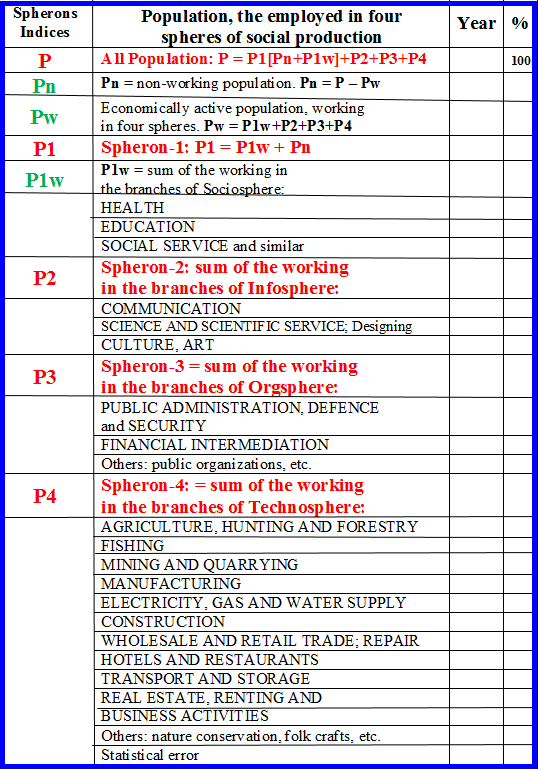
5. Summary of the spherons verification methods Find on the Internet the statistics of any territorial object: municipality, district, city, region, country, continent or humanity in two parameters: "Demography" and "Employment" for any past year, and summarize its indices (right) into spheral (main and intermediate) indices in Table-5 (left). For the production enterprises and institutions of various kinds, the personnel statistics and staffing are sufficient. To formalize the result and publish it in scientific journals and websites, primarily on the GGHA website "Peace from Spherons Harmony" (https://peacefromharmony.org). All our peacemaking primer coauthors are invited to conduct a similar statistical verification of their country, city, university, etc. spherons in order to be sure in our global peace paradigm truth. All of them will be published in our primer. Leo Semashko, 18-06-23 ----------------------------------
Paragraph 7. Digital Technology of Spheral Statistics. Dear coauthors-peacemakers, We are glad to send you for discussion in dialogue with your objections and questions the 7th paragraph (7 pages) of our peacemaking primer until June 22 inclusive. This paragraph is published here: https://peacefromharmony.org/?cat=en_c&key=1138 In the future, this 6-picture paragraph will either be shortened or split into two. We emphasize that in our paragraphs, as drafts, the bibliography is only outlined. It will be finally created at the primer final stage in the fall. Best wishes for your health and true peace, LeoSemashko, 18-06-23 ----------------------
Dialogue: Pro and Contra --------------------------------------------
Up
|